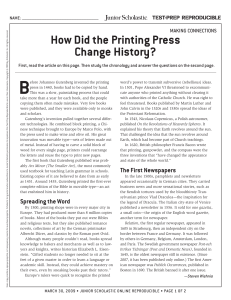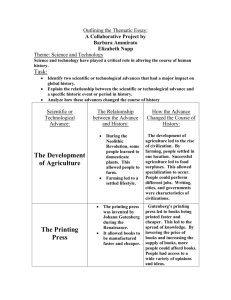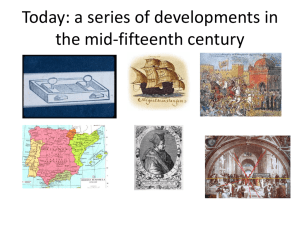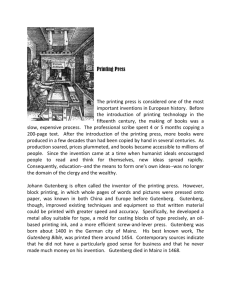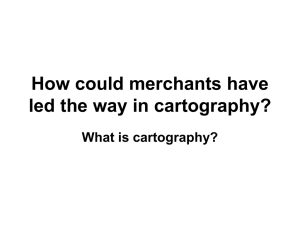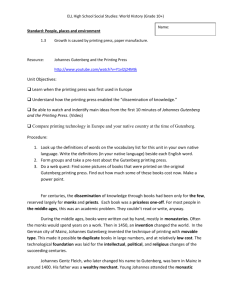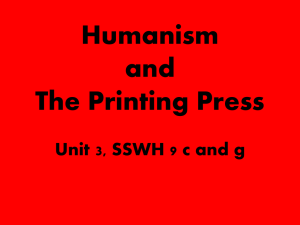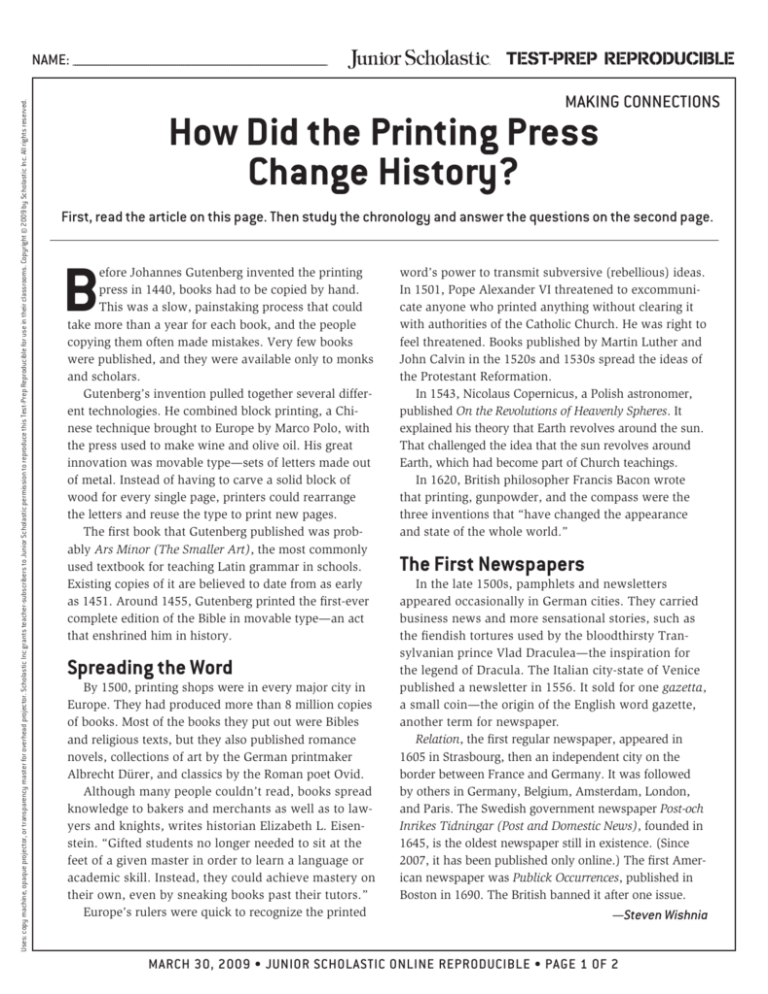
Uses: copy machine, opaque projector, or transparency master for overhead projector. Scholastic Inc grants teacher-subscribers to Junior Scholastic permission to reproduce this Test-Prep Reproducible for use in their classrooms. Copyright © 2009 by Scholastic Inc. All rights reserved.
NAME: __________________________________________________________________________________________________________________________
®
test-prep reproducible
making connecTIONS
How Did the Printing Press
Change History?
First, read the article on this page. Then study the chronology and answer the questions on the second page.
B
efore Johannes Gutenberg invented the printing
press in 1440, books had to be copied by hand.
This was a slow, painstaking process that could
take more than a year for each book, and the people
copying them often made mistakes. Very few books
were published, and they were available only to monks
and scholars.
Gutenberg’s invention pulled together several different technologies. He combined block printing, a Chinese technique brought to Europe by Marco Polo, with
the press used to make wine and olive oil. His great
innovation was movable type—sets of letters made out
of metal. Instead of having to carve a solid block of
wood for every single page, printers could rearrange
the letters and reuse the type to print new pages.
The first book that Gutenberg published was probably Ars Minor (The Smaller Art), the most commonly
used textbook for teaching Latin grammar in schools.
Existing copies of it are believed to date from as early
as 1451. Around 1455, Gutenberg printed the first-ever
complete edition of the Bible in movable type—an act
that enshrined him in history.
Spreading the Word
By 1500, printing shops were in every major city in
Europe. They had produced more than 8 million copies
of books. Most of the books they put out were Bibles
and religious texts, but they also published romance
novels, collections of art by the German printmaker
Albrecht Dürer, and classics by the Roman poet Ovid.
Although many people couldn’t read, books spread
knowledge to bakers and merchants as well as to lawyers and knights, writes historian Elizabeth L. Eisenstein. “Gifted students no longer needed to sit at the
feet of a given master in order to learn a language or
academic skill. Instead, they could achieve mastery on
their own, even by sneaking books past their tutors.”
Europe’s rulers were quick to recognize the printed
word’s power to transmit subversive (rebellious) ideas.
In 1501, Pope Alexander VI threatened to excommunicate anyone who printed anything without clearing it
with authorities of the Catholic Church. He was right to
feel threatened. Books published by Martin Luther and
John Calvin in the 1520s and 1530s spread the ideas of
the Protestant Reformation.
In 1543, Nicolaus Copernicus, a Polish astronomer,
published On the Revolutions of Heavenly Spheres. It
explained his theory that Earth revolves around the sun.
That challenged the idea that the sun revolves around
Earth, which had become part of Church teachings.
In 1620, British philosopher Francis Bacon wrote
that printing, gunpowder, and the compass were the
three inventions that “have changed the appearance
and state of the whole world.”
The First Newspapers
In the late 1500s, pamphlets and newsletters
appeared occasionally in German cities. They carried
business news and more sensational stories, such as
the fiendish tortures used by the bloodthirsty Transylvanian prince Vlad Draculea—the inspiration for
the legend of Dracula. The Italian city-state of Venice
published a newsletter in 1556. It sold for one gazetta,
a small coin—the origin of the English word gazette,
another term for newspaper.
Relation, the first regular newspaper, appeared in
1605 in Strasbourg, then an independent city on the
border between France and Germany. It was followed
by others in Germany, Belgium, Amsterdam, London,
and Paris. The Swedish government newspaper Post-och
Inrikes Tidningar (Post and Domestic News), founded in
1645, is the oldest newspaper still in existence. (Since
2007, it has been published only online.) The first American newspaper was Publick Occurrences, published in
Boston in 1690. The British banned it after one issue.
—Steven Wishnia
March 30, 2009 • JUNIOR SCHOLASTIC online reproducible • page 1 of 2
Uses: copy machine, opaque projector, or transparency master for overhead projector. Scholastic Inc grants teacher-subscribers to Junior Scholastic permission to reproduce this Test-Prep Reproducible for use in their classrooms. Copyright © 2009 by Scholastic Inc. All rights reserved.
NAME: __________________________________________________________________________________________________________________________
chronology
1398: Johannes Gutenberg is born
in Mainz, Germany.
1440: Gutenberg first displays the
®
questions
1. How were books made before the printing press was
invented?__________________________________________________________________________
___________________________________________________________________________________________
2. How long did it take to make a book before the
invention of the printing press?_____________________________________
___________________________________________________________________________________________
printing press.
1451: Gutenberg publishes the
Latin textbook Ars Minor.
3. What was Gutenberg’s key innovation? How did it
help?__________________________________________________________________________________
___________________________________________________________________________________________
___________________________________________________________________________________________
1455: Gutenberg publishes the first
printed version of the Bible.
1468: Gutenberg dies.
1475: William Caxton prints the
first English-language book.
4. What were the first books Gutenberg printed?
___________________________________________________________________________________________
5. When did the first regular newspaper come out?
___________________________________________________________________________________________
6. Name two subjects in which books published in the
1500s challenged established ideas.
___________________________________________________________________________________________
1501: Pope Alexander VI tries to
censor printed matter.
7. How were people able to learn from books in ways
that they couldn’t before printing was invented?
___________________________________________________________________________________________
___________________________________________________________________________________________
___________________________________________________________________________________________
1520: Martin Luther publishes
three books.
1543: Copernicus publishes his
astronomical theories.
1556: The city-state of Venice
8. What large group of Europeans was unable to do this?
___________________________________________________________________________________________
9. Why might some people in power want to censor
books and other printed matter?___________________________________
___________________________________________________________________________________________ ___________________________________________________________________________________________
publishes a newsletter.
1605: Relation, the first regular
newspaper, is first published
in Strasbourg.
1690: The first and only issue of
Publick Occurrences, the
first American newspaper, is
published in Boston.
test-prep reproducible
10. Do you think that the Internet and computers are
having as big an impact on society as the invention of
printing? Why or why not?______________________________________________
___________________________________________________________________________________________
___________________________________________________________________________________________
___________________________________________________________________________________________
___________________________________________________________________________________________
___________________________________________________________________________________________
___________________________________________________________________________________________
March 30, 2009 • JUNIOR SCHOLASTIC online reproducible • page 2 of 2

